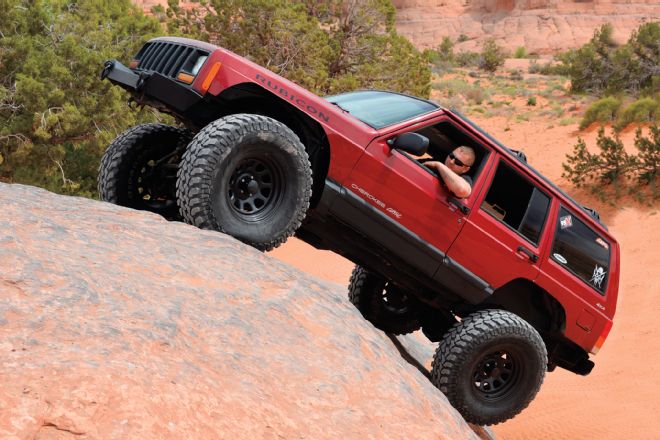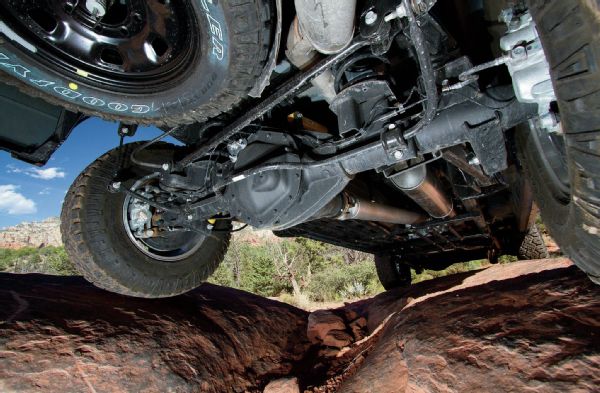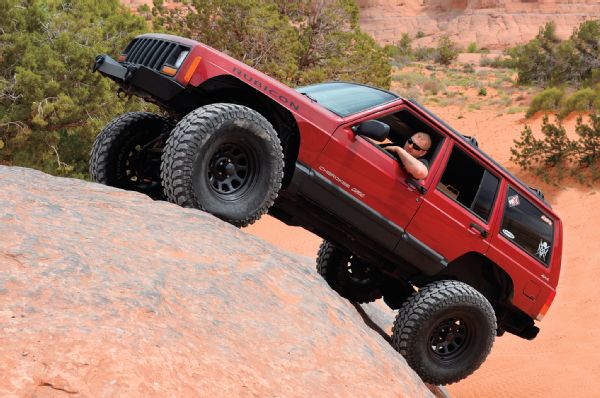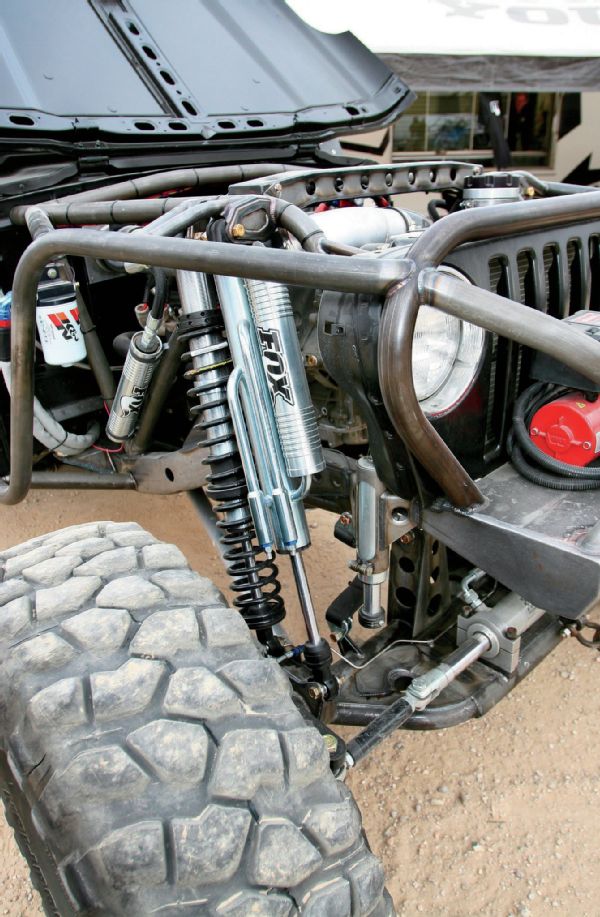
 John Cappa
Former Editor, Four Wheeler
John Cappa
Former Editor, Four Wheeler
1-Ton Expedition Swap
Q: I plan on swapping the entire drivetrain out of a late 1990s Ford F-350 into my 1999 Ford Expedition. I want to use the five-speed manual transmission and manual transfer case with the Dana 60 front and the Sterling 10.5-inch rear. I plan to use Deaver long-travel 7-inch-lift leaf springs and a shackle lift as well. Any ideas on how to mount the leaf springs on the frame?
Chase Harris
Via fourwheeler.com
A: It sounds like a pretty involved project that will require a lot of technical and precise measuring and fabrication. Hanging the springs will likely be one of the more difficult parts of your project. To start with, you will need to space the springs on the frame the same distance as the center pin holes on the front axle. You’ll also want to take into consideration the caster of the axle. This will be dictated by the design and overall length of your leaf springs, as well as the design of the spring brackets and shackles. I would start by bolting the leaf springs to the front axle, making sure the springs are perfectly perpendicular to the axle. Measure from spring tip to spring tip to get them absolutely straight, prior to cinching the U-bolts down. Then you can slide the whole assembly under the vehicle and set caster at around 3-5 degrees positive. From there, you can start fabricating your spring mounts and shackles. The axle will need to be centered in the wheelwells, and depending on which end you install the shackles, you’ll need to compensate one way or the other for the movement of the axle centerline as the suspension compresses. This compensation amount will depend on the arch of the springs and overall spring design. It may sound complicated, but you really need to get these measurements correct, or you will run into handling and tire-rubbing problems down the road.
Factory Electric Locking
Q: I am hoping you can answer my question as the dealers have no clue on custom applications. I purchased and installed the Power Wagon electric locker in my ’06 Ram 2500 AAM 9.25 front axle. It was a simple install and works great, even taking a pounding from the Cummins diesel on 37s. I have read that the new 2014 Ram Power Wagon now uses the bigger AAM 11.5 rear axle versus the old AAM 10.5 housing. My truck uses the AAM 11.5 rear axle as well, and I’m wondering if the locker for the 2014 Power Wagon could be installed in my 2006 axle? I haven’t seen any articles on this, so have at it! I figure if anyone, you guys would know.
Mark Harlow
Via email

A: The Power Wagon electric lockers are relatively simple and certainly easy to wire up. All they need to function is a 12-volt switched power source. I can see the appeal and don’t know of any reasons why you couldn’t put this locker in your truck. However, keep in mind that the locker was likely never designed to take the kind of torque that the Cummins engine can develop. I’m sure it will be fine in all but the most abusive situations. If you plan on adding much larger tires and use the truck very aggressively off-road, you may want to consider something like an ARB Air Locker (arbusa.com), which has been designed and tested for strength in overly abusive applications.
XJ or WJ
Q: I will be returning to New York from a three-year tour in Germany, and I am ready to do some wheelin’. I also need a vehicle that can handle the winter season. I have been looking at the 1998 to 2001 Jeep Cherokee. I have read those are great platforms for reliability and function. What are the common problems with those years, and what year Grand Cherokees are good and what are their common problems? I’m looking for a solid off-road platform that I can lightly modify for under $7,000.
Ted K.
Via fourwheeler.com

A: The 1997 to 2001 Cherokee is a great platform to start with. The 4.0L inline-six and AW4 four-speed automatic are a fantastic powertrain combo that can easily last up to and over 250,000 miles if the owner performed regular maintenance and oil changes. The electrical components are often finicky. Things like power windows and seats may no longer work properly, but they can be fixed. Non-functioning A/C is another issue that can be a very expensive repair that stems from a problem inside the ducting and the mechanisms behind the dash. I’d look for one that has not been modified or abused off-road. Crawl underneath the Jeep and take a look. If the skidplates are scratched, banged up, bent, missing, or packed with mud and dirt, then you might want to find a different Jeep. Most off-road enthusiasts try to steer clear of the Selec-Trac NP242 transfer case. However, it’s a great transfer case for areas that see a lot of snow and ice, especially if you don’t plan to go with 35-inch or bigger tires. The NP242 offers a part-time 4x4 shift option that works great on slick streets.
As for Grand Cherokees, you’ll want to look for a 1999 to 2004 WJ. Since these Jeeps are getting up there in age, it’s best to find one with the reliable 4.0L inline-six. As with the XJ Cherokees, the Grands will generally have some interior electrical issues. The viscous coupler found in the full-time Grand Cherokee transfer case is prone to fail, especially if the Jeep has a lift and larger-than-stock tires. The good news is you can easily swap in an NV231 transfer case if need be.
Both the XJ and WJ Jeeps are great platforms to build on. There are plenty of parts available in the aftermarket to do just about anything to them.
Mud Tired
Q: I have a 1994 XJ Cherokee, and I’m installing a Rubicon Express 3.5-inch Super Flex short-arm lift. I’m trying to decide what kind of tires to use. I have been researching different brands and would like some input from other wheelers. I previously used 31x10.50R15 Radial Mud Claws on my 1989 XJ and they were nice, but I’m going to upgrade to 33x12.50 tires. I know I need to cut the fenders and I already have Pro Comp wheels with 3.75 inches of back spacing. This Jeep will rarely see city roads and will be primarily used on the trails and in the mud.
McMuddin
Via fourwheeler.com
A: There are many different mud tires that will work in your application. A lot will depend on aesthetics and personal preference. I would recommend checking out the Four Wheeler tire guide, complete with ratings from the editors. You can find this guide at http://bit.ly/1dtlGMt.
Wagner Whining
Q: I took my 1977 Ford F-150 wheeling this weekend. I can’t see s#!t out of this thing. I hit every rock on the trail!
You guys that try to convince readers to wheel their fullsize trucks are not doing them any favors!
Harry Wagner
Via email
A: Sorry you had troubles, Harry. Driving a fullsize truck on the trail is quite a bit different than driving a small Jeep or mini-truck. Physically fitting the larger dimensions through obstacles is only part of the challenge. The section of the trail that disappears under the hood is much bigger on a fullsize 4x4, making memorization of the obstacles that much more important.
If you thoroughly enjoy extreme trails and are trying to avoid body damage, it’s likely that a fullsize truck isn’t for you. But the challenge of piloting a big pig over the trail can be fun if you have the right attitude and heavy-duty components.
I once modified a 1979 Ford F-150 for regular trail work, and like you, I couldn’t see much. So I added another window. The old Fords have an advantage in this aspect. I had already removed the inner fenders to fit bigger tires. The dashboard and heater box were removed to save weight. But rather than cover the heater box hole with steel or aluminum, I used a sheet of Lexan. This offered a great view of the passenger side of the truck and of the right front tire. The extra window was even useful in the dunes. I could come up and over a razorback at an angle and see what was on the other side while there was nothing but blue sky in the windshield.
There are other options as well. Several companies offer trail cameras that you can mount to the outside of the 4x4 to cover your blind spots. A small monitor in the cab gives a full view. The less expensive, although somewhat more annoying alternative is to make sure you always have a reliable spotter that you can trust and understand.
On the plus side, people like watching fullsize trucks tackle a trail. It’s awesome to watch a large mass of steel navigate through a sea of Wranglers. It’s easy to fall in with the herd and build a Jeep. It’s much more fun to be different and build a fullsize trail truck.
Shocking Off-Road Car
Q: I am building an off-road car. I had planned to use Fox suspension for our vehicle, but due to the cost, this idea has been discarded. Can you suggest any other type of suspension that we should use as an alternate to Fox suspension that is cheap and light in weight?
Saurabh.Offroadfreak
Via fourwheeler.com

A: It sounds as though you had planned on using Fox (ridefox.com) coilovers or air shocks. Fox does not offer complete suspension kits. Unfortunately, coilovers and air shocks require a lot of precise machining. This process is costly. There are several manufacturers that offer coilovers and air shocks. The entry-level models are all priced very similarly so I’m not sure that this is the route you should take. If you are trying to fabricate a reliable link suspension, perhaps you can use regular coils from the aftermarket or the junkyard and then spend a little extra on the shocks. Fox offers shocks without a coilover that should work in your application and fit the budget.
Where To Write
Have a 4x4 tech question you want answered in Techline, drop an email to fourwheelereditor@sorc.com or head on over to our forums at fourwheeler.com. All letters become the property of Four Wheeler, and we reserve the right to edit them for length, accuracy, and clarity. Due to the volume of mail, electronic and otherwise, we cannot respond to every reader, but we do read everything.